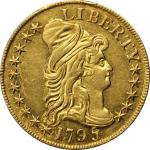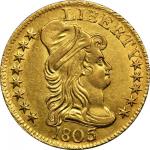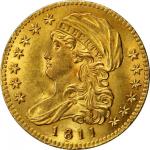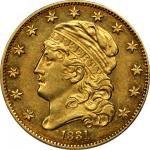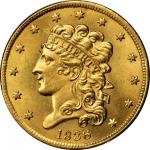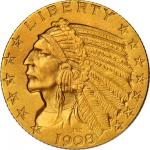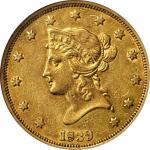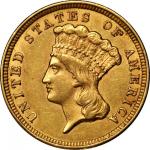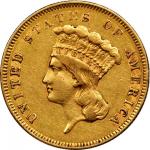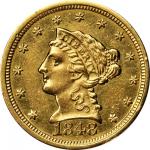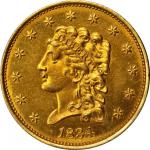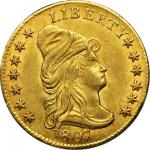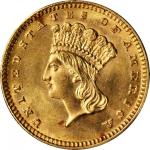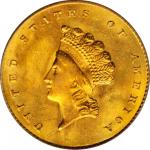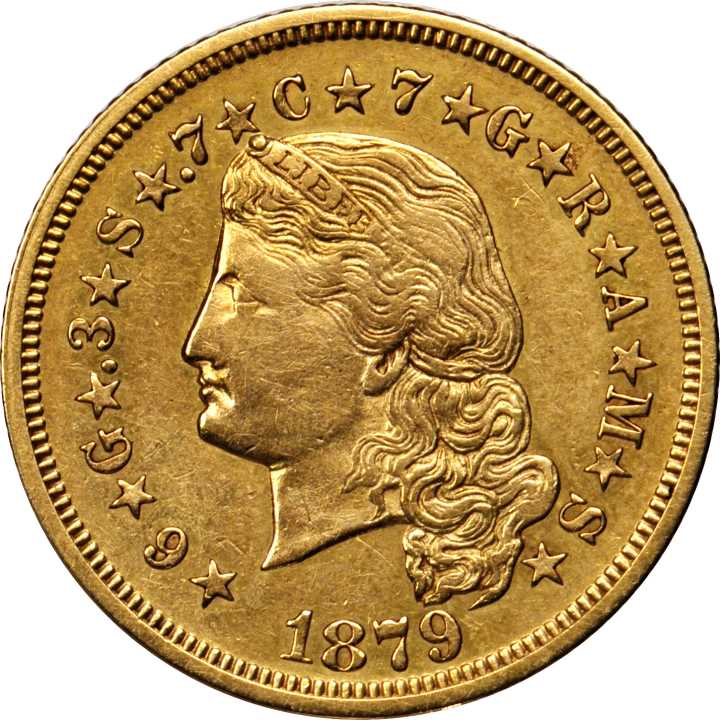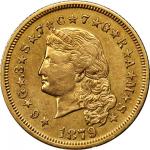Presumably struck in standard alloy of 90% gold, 10% copper. <strong>Obv:</strong> Charles E. Barbers design for the four-dollar Stella with a head of Liberty facing left. Liberty is wearing a coronet inscribed LIBERTY, and her hair is long and flowing. The inscription * 6 * G * .3 * S * .7 * C * 7 * G * R * A * M * S * is around the border and the date 1879 is below. <strong>Rev: </strong>A five-pointed star, or Stella, with the Latin mottoes E PLURIBUS UNUM and DEO EST GLORIA in the surrounding field. The star in scribed ONE STELLA and 400 CENTS, the legend UNITED STATES OF AMERICA is above, and another expression of the denomination FOUR DOL. is below. This is an attractive example with warm khaki-gold patina. Light rub to the high points suggests that this coin is a former pocket piece, but if so it was used as such for only a brief period of time, and without acquiring any defects. Indeed, the surfaces are relatively smooth in outward appearance, and the devices retain bold to sharp definition over virtually all design elements. A handsome representative of this classic issue, the denomination as a whole is so popular with numismatists as to be included in the 2003 book 100 Greatest U.S. Coins by Jeff Garrett and Ron Guth.The story of the four-dollar gold Stella begins in Europe in 1865 with the establishment of the Latin Monetary Union in which several of the major economic powers of their day established a unified monetary standard. This economic union, which lasted officially until 1927 and was a predecessor of todays EU, allowed gold and silver coins of many nations to circulate freely at the same weight and purity standard, easing commerce within Continental Europe. American travelers abroad noted the ease with which currency exchange could be performed within the union, comparing it to the greater difficulty of converting American coins. These challenges prompted several attempts to adapt American gold coinage to conform to the standards established by the Latin Monetary Union. One attempt in 1874 went so far as to produce a few pattern ten-dollar coins based on a proposal by Dana Bickford (the "Bickford eagle"), but did not progress far beyond the concept phase.In 1879, another proposal along similar lines gained significant momentum when John A. Kasson, the United States minister plenipotentiary to the Austro-Hungarian Empire and a former chairman of the Congressional Committee on Coinage, Weights and Measures suggested the creation of a four-dollar gold coin to facilitate trade abroad. This four-dollar coin would be closer in weight than the five-dollar half eagle to the most popular European gold coins then in circulation, including the Austro-Hungarian 8 florin piece, a coin with which Kasson was particularly familiar. The proposed new denomination would be minted in a metric gold alloy of 85.71% gold, 4.29% silver and 10.00% copper based in part on a similar silver alloy called "goloid" patented by Wheeler W. Hubbell of Pennsylvania. The proposal was referred to the current Coinage Committee chairman, Alexander Stephens, who then wrote to Secretary of the Treasury John Sherman requesting that the Mint prepare patterns of the denomination for Congressional evaluation. Two designs were prepared, the Flowing Hair design by Charles E. Barber, as here, and the Coiled Hair design by George T. Morgan, an example of which is offered in the following lot. While the obverse legend states the composition of the goloid alloy in the coin, the patterns were almost certainly produced in standard alloy of 90% gold and 10% copper, though none have been subjected to the required analysis to prove whether or not this is indeed the case. The proposed new name for the denomination, Stella, refers to the five-pointed star used in the reverse design and was based, "in analogy to one eagle, both the star and eagle being national emblems on our coins." The Barber Flowing Hair design was selected initially and just 25 (possibly as few as 10 or 15) three-piece pattern Proof Sets were prepared for distribution to Congressional leaders. The coins proved to be popular among government officials, the ensuing demand for additional specimens was so great that the Mint was obliged to strike several hundred more examples in 1880, all bearing the 1879 date. Estimates of production figures vary from the traditionally accepted figure of 425 pieces to more modern totals of upward of 800 coins struck. In the end, however, the proposed denomination failed to garner enough support to be authorized and, as such, was never put into regular issue production.While never issued for circulation and by all definitions a pattern, the Stellas long-time inclusion in the popular Guide Book of United States Coins has made the denomination an essential part of a complete type set of classic U.S. Mint coinage. Arguably among the most intriguing Stellas extant are those 1879 Flowing Hair examples that were obviously used as pocket pieces by their former owners. Such pieces, the present example likely included, confirm the popularity of these ultimately ill-fated coins with the Congressional leaders and other government officials tasked with ascertaining their potential usefulness. It is, indeed, more than a little ironic that the same national leaders who held the Stella in such high regard as a personal keepsake, in the end failed to establish it as a permanent part of United States coinage. The acquisition of this coin would be a crowning achievement for even advanced collectors.


